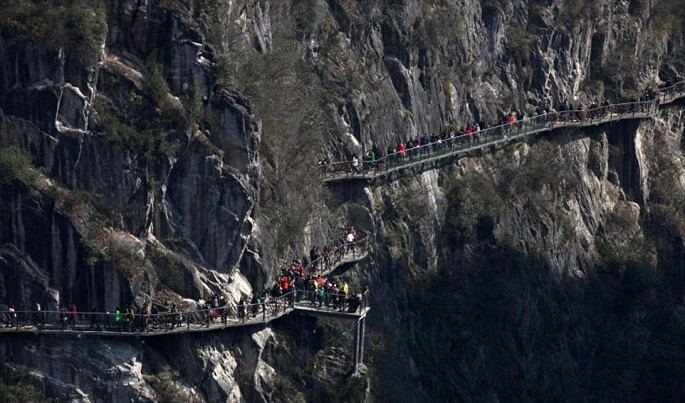Going for a walk?
There’s one that definitely provides an unobstructed scenic view and renders a different kind of high both in the figurative and literal sense of the word.
An important reminder, though, to those who are faint of heart and are afraid of heights: the walk will find one making steps beside--not on top--a canyon through a bridge with a 1,640-foot (500-meter) drop.
Tourists, majority of which are locals, brave the 5-mile-long bridge built at the edge of the Guanyin Cliff Grand Canyon in Chongqing Qianjiang Urban Canyon Park.
The Fuling Wuling tourism board concocted the idea of this seemingly endless walkway, constructed with a 600 million yuan (about $91 million) price tag, reported Mail Online.
Originally planned to open in May 2015, the walkway welcomed the public only in January.
The canyon on this part of Chongqing serves as a splendid example of a karst landscape.
The Canadian Encyclopedia defines a karst landform as “a geological feature created on the earth's surface by the drainage of water into the ground.”
The term “karst” comes from the name of a Slovenian region. Researchers initially conducted a comprehensive study of karst forms in Kras, Slovenia.
Karst areas dot China.
Yunnan Province’s Shilin, also referred to as the Stone Forest because the massive and towering limestone formations appear to be like trees, attracts tourist to explore its landscape and a couple of lakes and caves and a waterfall.
Chongqing’s Furong Cave in Wulong County displays karst limestone stalactites.
Another splendor in Wulong County, Xiannushan Town’s Three Natural Bridges impress as natural limestone bridges. The Chinese used names of dragons to identify these works of nature: Heilong (“Black Dragon”) Qinglong (“Azure Dragon”) and Tianlong (“Sky Dragon”).
Shilin, Furong Cave and the Three Natural Bridges belong to the South China Karst. It prides itself as a UNESCO World Heritage Site.
Walkways, many of which are even glass-bottomed, seem to tickle the Chinese people’s fancy a lot as evidenced by the number of existing ones and the throng of tourists frequenting them.
For thrill-seekers, they can go to Hunan Province and visit the suspension bridge in Pingjiang County and the walkway in Yuntai Mountain Geological Park, which are both glass-bottomed.
Another glass-bottomed walkway in Zhangjiajie’s Tianmen Mountain in Hunan will open to the public in May, according to Mail Online.
Go try all these bridges--but watch where you’re going.



























